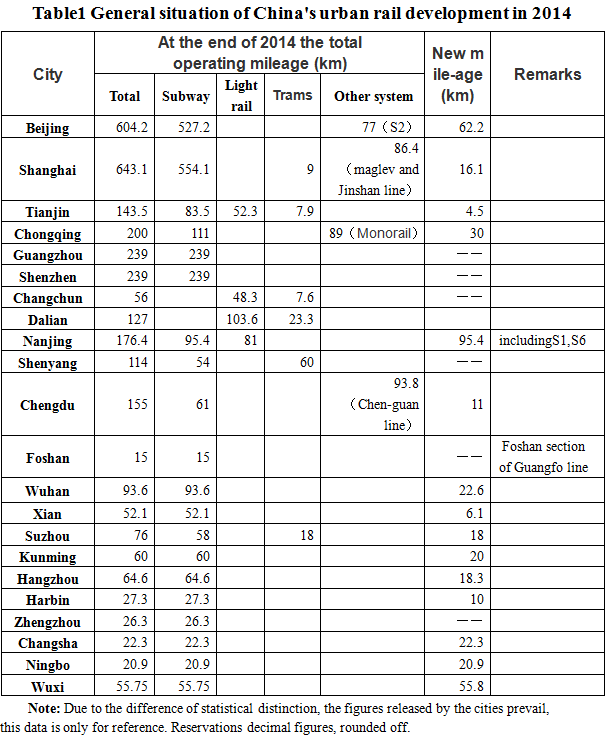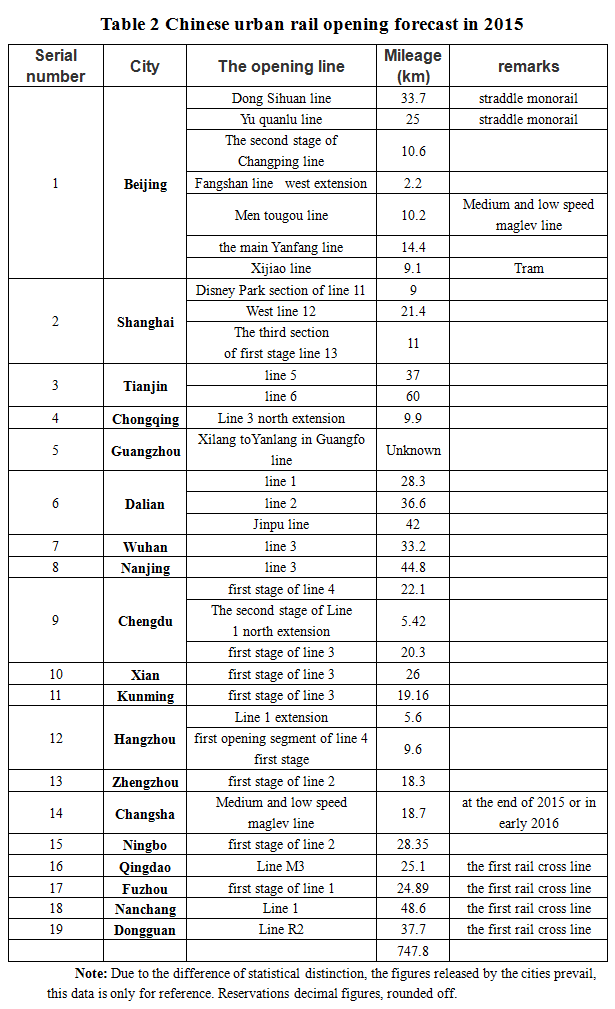The Survey of Urban Rail Development of China in 2014
2015-01-19After more than ten years experience of rapid development, the number of Chinese cities which have urban rail traffic has increased from 3 in 2000 (Beijing, Shanghai, Guangzhou) to 22 in 2014. Moreover, by the end of 2014, the total traffic mileage of China's urban rail has more than 3000 km (including metro, tram, etc.).Among them, only in 2014, China will have 13 cities opened new line of urban rail transit (Changsha, Ningbo, Wuxi, opened urban rail transit lines for the first time).
China’s Urban Rail Develops Rapidly in 2014
In 2014, China's urban rail development momentum remains strong. According to statistics, there are 16 cities having added mileage of urban rail transit with a total of 386 km, 13 of which are increasing new line with a total of 366 km. The Changsha, Ningbo, Wuxi opened the first subway in 2014.
By comparing Chinese added urban rail mileage in 2013, it’s easy to find out that the opening of the new urban rail will maintain at a high level, but slightly lower than that in 2013(according to China association of metros statistical data, new added urban rail mileage is 460km in 2014)
China’s Urban Rail Develops Rapidly in 2014
In 2014, China's urban rail development momentum remains strong. According to statistics, there are 16 cities having added mileage of urban rail transit with a total of 386 km, 13 of which are increasing new line with a total of 366 km. The Changsha, Ningbo, Wuxi opened the first subway in 2014.
By comparing Chinese added urban rail mileage in 2013, it’s easy to find out that the opening of the new urban rail will maintain at a high level, but slightly lower than that in 2013(according to China association of metros statistical data, new added urban rail mileage is 460km in 2014)

Chinese Urban Rail Opening Forecast in 2015
After years of development, 2015 will be a peak in Chinese urban rail development. According to preliminary statistics, Qingdao, Fuzhou, Nanchang, Dongguan four cities will open a new line in 2015 which is a considerable growth as previous years. This is a further evidence of sustained and healthy development of China's urban rail transit.
To be sure, China's urban rail construction market will be further expanded in 2015. First, the urban rail network in Beijing, Shanghai and other cities further present intensive situation, urban rail will extend to the out skirts of the city by using the form of the city fast-track to form a larger network structure. Second, rail network of the cities which have built the city urban rail will be further accelerated in the background of the new urbanization, and the second-tier cities will face the structure of metro rail and other rail common development, which will undoubtedly lead the diversified development of the industry and add more charm to Chinese cities. Third, due to the scale of economic development and urban population, the new tram rail is expected to have a greater acts in medium and small cities.
According to statistics, the number of city which has urban rail will reach 30 by the end of 2015, of which 19 cities will open the new line or open extension line on the foundation of the opening line in 2015.

There is a need to explain, the vast majority of the urban rail mentioned in table 2 is subway system, but little tram and the City fast track. One reason is that this new modern tram standard approval authority is in each city, so the statistics are relatively difficult; on the other hand, the vast majority of the city's fast-track will use the existing main line railway to transform, and the construction will focus on the front-line cities, therefore, it is relatively difficult to statistics.
We can say that 2015 will usher a climax in the open of China’s urban rail line, then, the total mileage of China's urban rail will reach about 3500 km. In addition, with the accelerating progress of the preparation or the approval of rail transportation planning in dozens of cities, including Jinan, Luoyang, Hohhot, Xining, Quanzhou, Yichang, Zhongshan, Handan, Jiujiang, Yangzhou, etc., China's urban rail transit industry will still maintain a stable development trend in 2015 and the coming years.
We can say that 2015 will usher a climax in the open of China’s urban rail line, then, the total mileage of China's urban rail will reach about 3500 km. In addition, with the accelerating progress of the preparation or the approval of rail transportation planning in dozens of cities, including Jinan, Luoyang, Hohhot, Xining, Quanzhou, Yichang, Zhongshan, Handan, Jiujiang, Yangzhou, etc., China's urban rail transit industry will still maintain a stable development trend in 2015 and the coming years.






